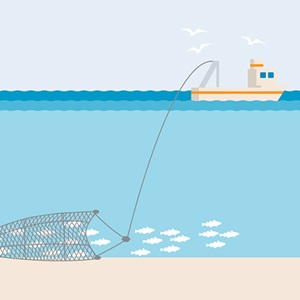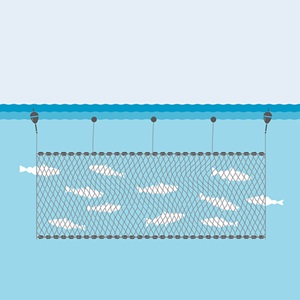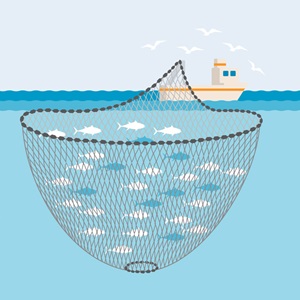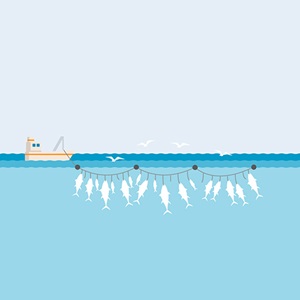Is seafood caught using midwater trawls sustainable? Find out more about this method of fishing and how its impact on the ocean can be reduced.
What are midwater trawls?
Unlike bottom trawling, which targets species near the seafloor, midwater trawling is used to catch fish that swim in open water.
Midwater trawling, also known as pelagic trawling, involves towing a large net through the water column to catch pelagic (midwater) fish species.
The entire water column of the open ocean is known as the pelagic zone and is split into layers; the upper 200m depth is the epipelagic zone, followed by the mesopelagic zone, which reaches 1000m. Most midwater trawls operate in these top two layers.
/pelagic-or-midwater-trawl-illustration.tmb-large1920.jpg?Status=Master&Culture=en&sfvrsn=7de237f_1)
How do midwater trawls work?
Midwater trawl nets have a cone-shaped body and a closed ‘cod-end’ that holds their catch. The size of the mesh is designed to target specific species of fish. Fish are herded into the net and guided towards the cod-end, where they are collected.
The trawl net is deployed from the back of the vessel with floats at the top and weights at the bottom to maintain its opening vertically. Angled boards, known as otter boards or trawl doors, attached to the sides hold the net open horizontally.
Midwater trawlers use sonar to locate and precisely target schools of fish in the water column. The sonar system detects the school and determines its depth and size. Acoustic sensors on the net provide real time feedback to the vessel, allowing for fine-tuning of the net’s position.
Single boat and pair trawling
Midwater trawls are generally much larger than bottom trawls and can be towed by one or two boats. When two vessels work together (pair trawling), each vessel tows one side of the net and this maintains its horizontal spread. Pair trawling allows for a larger net and can cover a greater area, making it more efficient for targeting large schools of pelagic fish.
Other types of midwater trawl
Pelagic pair trawling with purse seine features incorporate elements of purse seine fishing, such as a closing mechanism at the bottom of the net. Once the net is filled, a purse line pulls the bottom of the net closed. This prevents fish from escaping and allows for efficient capture of large schools.
Semi-pelagic trawl fishing is a hybrid between bottom trawling and midwater trawling. These nets can operate both near the seabed to target demersal species and higher in the water column for pelagic species. The net is rigged to allow adjustment of its depth during towing.
Which species of fish are caught by midwater trawling?
Midwater or pelagic trawl nets are designed to capture large aggregations of schooling species, including herring, mackerel, anchovy, sardines, pollock, blue whiting, horse mackerel, sprat, capelin, and jack mackerel.
Midwater trawling is also ideal for catching smaller, slow swimming species, and is used in the fishing of Antarctic krill. Less commonly, the gear can also be used to target larger, faster moving schooling species such as tuna.
What are the environmental impacts of midwater trawls?
All types of fishing gear can have significant impacts on the ocean environment if not sustainably managed.
Overfishing
Inappropriately sized mesh in trawl nets can result in overfishing: when too many fish in a particular stock are caught and there are not enough mature adults left to breed and maintain the population’s numbers. For example, mesh that is too small can result in the capture of juvenile fish, which are then jettisoned as unwanted catch or discards.
Inappropriately sized mesh use may also constitute illegal fishing, if it in contravention of local or international fishing regulations.
Bycatch
Inappropriate mesh size can be unselective with regard to other species and incur large amounts of bycatch.
Bycatch is the unintentional capture of non-target species, that can also include Endangered, Threatened and Protected (ETP) species such as sharks, rays, turtles, birds and marine mammals like dolphins, porpoises and whales.
Habitats
As midwater trawls are designed to have little contact with the seabed this reduces habitat disturbance and avoids physical impacts with habitats at the bottom of the ocean.
However, lost or abandoned fishing gear can act as ghost gear that may continue to trap marine life. Ghost gear can also beach and become entangled on coral reefs and other sensitive habitats. Discarded gear pollutes the marine environment, with long-term effects on the wider marine ecosystem.
How MSC Certified fisheries are improving
How can midwater trawl fishing reduce its environmental impacts?
All MSC certified fisheries must demonstrate their fishing operations and gear have low impacts on the environment. To be certified as sustainable against the MSC Fisheries Standard, fisheries are often required to make improvements to their fishing operations.
Improvements include increased onboard monitoring and independent observer coverage, and mitigating interactions with non-target species through gear modifications. Voluntary improvements can include retrieval and recycling of lost gear to prevent ghost fishing.
How do midwater trawl fisheries prevent overfishing?
Modified netting with appropriately sized mesh can prevent overfishing. An appropriate mesh size avoids catching juvenile fish, allowing them to swim free and reach maturity. Modifications to mesh size improve the selectivity of the gear and allow for the escape of species that are a different size to the target species.
How do midwater trawl fisheries reduce bycatch?
Sustainable midwater trawl fisheries modify their gear with bycatch reduction devices to avoid catching non-target and ETP species.
Bycatch reduction devices are gear or trawl modifications that allow non-target catch to escape the trawl. For example, some Antarctic krill fisheries have installed whale and seal exclusion devices to the mouths of their trawl nets.
Some other midwater trawl fisheries modify their nets with turtle exclusion devices – a set of bars that prevents turtles and sharks from entering the trawl mouth.
Modifying mesh size also prevents potential bycatch species from entering the nets.






